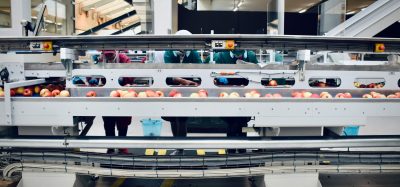In a nutshell… Doug Baldwin, Vice President of the Food and Industrial Products Division at Wenger Manufacturing Inc.
- Like
- Digg
- Del
- Tumblr
- VKontakte
- Buffer
- Love This
- Odnoklassniki
- Meneame
- Blogger
- Amazon
- Yahoo Mail
- Gmail
- AOL
- Newsvine
- HackerNews
- Evernote
- MySpace
- Mail.ru
- Viadeo
- Line
- Comments
- Yummly
- SMS
- Viber
- Telegram
- Subscribe
- Skype
- Facebook Messenger
- Kakao
- LiveJournal
- Yammer
- Edgar
- Fintel
- Mix
- Instapaper
- Copy Link
Posted: 27 October 2014 | New Food | No comments yet
Recognised as a world leader with nearly 80 years of experience in providing technologies for extruded grains and cereals, Wenger Manufacturing continues to explore possibilities and bring new innovations to the industry. Recent developments have expanded the role extrusion can play in replacing traditional cereal processing methods…


Doug Baldwin, Vice President of the Food and Industrial Products Division at Wenger Manufacturing Inc.,
“Extrusion processing can offer numerous advantages over conventional methods for preparing cooked, ready-to-eat food products,” says Doug Baldwin, Vice President of the Food and Industrial Products Division at Wenger Manufacturing. Examples of those benefits include processing time, consistency, reduced energy and labour requirements, and improved food safety.
Focusing on the extrusion of cooked cereal grains and the new opportunities available with recent technical developments, Baldwin explains that some of these products, such as highly expanded snacks, cereals, infant cereals and porridges are perfectly suited to the high-shear extrusion processing typically associated with most single-screw and some twin-screw processes. Other products, such as extruded breakfast cereal flakes, require processing with much lower levels of mechanical energy, in order to avoid the destruction of starches that occur in high-shear environments.
Baldwin reveals that gelatinisation of starch granules occur as a function of moisture, heat, time or chemical modification. “Traditional extrusion cooking of cereal grains results in mechanical damage to the starch granules, giving varying levels of cold water soluble starch and depressed final viscosities. In some final products, this starch damage results in undesirable characteristics, such as the shortened bowl life of flaked cereals,” he says.
“Mechanical energy is dissipated into the extruder in the form of heat caused by shear or friction generated by pumping or conveying inefficiencies. On one end of the spectrum we have the traditional small, single-screw extruder intended for use in expanded snack products, typically operated in a relatively ‘dry’ state, relying primarily on this mechanical energy (i.e. friction) to carry out the gelatinisation of the starch prior to exiting the extruder die orifice. This same methodology can be employed for other cooked cereals – such as infant foods, which are intended to be instantly hydrated in water or milk for consumption, without any further cooking required. In a ‘medium’ shear environment, the extrudate would be typically be processed at a higher moisture content, and would rely on a mix of thermal and mechanical energy to achieve the desired level of cook. Water would typically be injected into the extruder barrel to facilitate textural development, viscosity development and to enhance conductive heat transfer.”
Until recently, the potential of a true ‘low’ shear extrusion process has been limited by the extruder technology available, but Baldwin explains that this requirement has been addressed through the recent development of the Wenger Thermal Twin extruder system: “Previous technology would typically operate with a thermal to mechanical energy ratio of 3:1. New screw, barrel and steam injection components of this revolutionary extrusion process allows the utilisation of greater amounts of thermal energy, providing significantly increased ratios – up to 30:1 for some applications.
“Due to its more ‘natural’ cooking process, compared to high-shear cook, Thermal Twin technology promises the ability to produce non-conventional products not previously possible through known extrusion processes.”
With process flexibility designed into the Thermal Twin cooking system, the specific mechanical energy inputs can be lowered dramatically when extrusion cooking cereal grains. These materials can still be completely cooked, but since the primary energy source is thermal energy, the amount of starch damage is greatly reduced. Additionally, the starch gelatinisation levels of the thermally extruded and cooked materials can be controlled from 50 to 95 per cent by varying the level of direct steam injection.
“An integral part of the Thermal Twin processing package is the new High Intensity Preconditioner (HIP),” says Baldwin. “Thanks to two independently driven shafts, which offer both speed and rotational direction control, the Wenger HIP allows a wide range of capacities, mixing intensities and retention times. All of which are tools at the disposal of the processor to precisely influence the operating parameters required to meet the desired final product characteristics.
“Extrusion processing has always allowed for a wide range of ingredients to be processed into desirable final products. The Thermal Twin extrusion process extends this range of product possibilities even further. One example of this is the development of extruded masa flours for tortilla production, providing a continuous, cost-effective and environmentally friendly alternative to traditional processing.”
The Thermal Twin cooking extruder and the process for extrusion cooking of cereal grains having limited cold-water viscosity are patent pending. For additional information regarding this process, contact Wenger Manufacturing at: [email protected]









